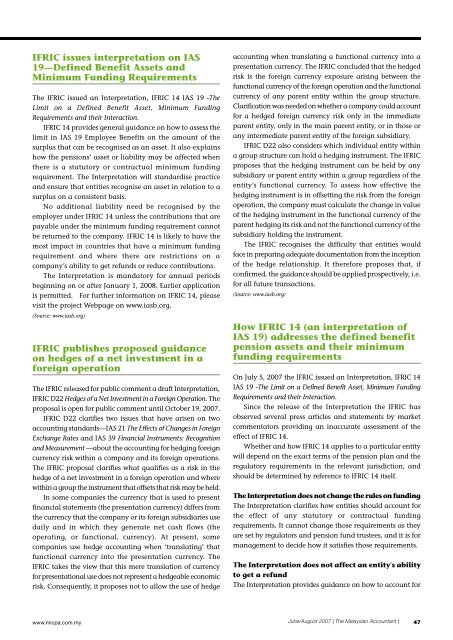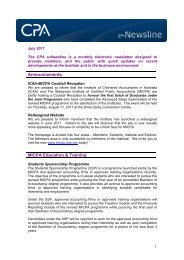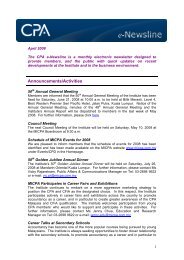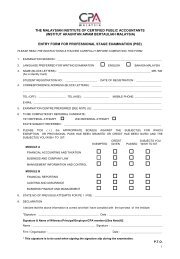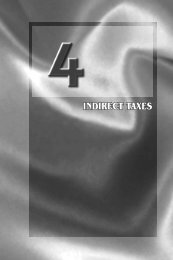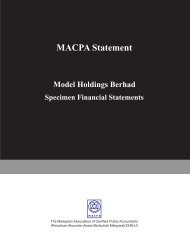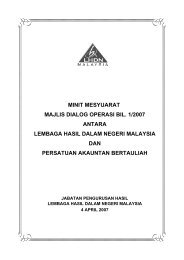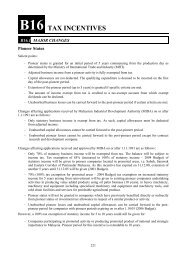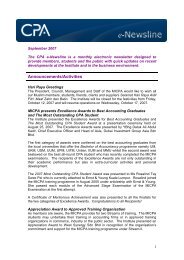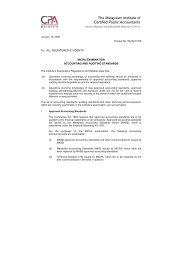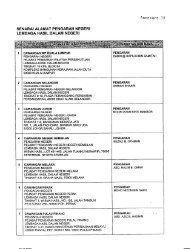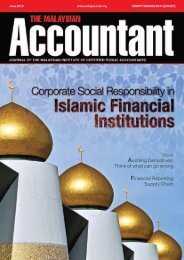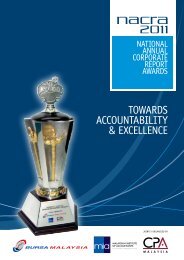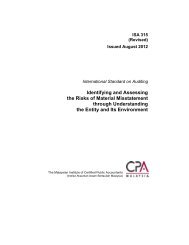The Malaysian Accountant - The Malaysian Institute Of Certified ...
The Malaysian Accountant - The Malaysian Institute Of Certified ...
The Malaysian Accountant - The Malaysian Institute Of Certified ...
Create successful ePaper yourself
Turn your PDF publications into a flip-book with our unique Google optimized e-Paper software.
IFRIC issues interpretation on IAS19—Defined Benefit Assets andMinimum Funding Requirements<strong>The</strong> IFRIC issued an Interpretation, IFRIC 14 IAS 19 -<strong>The</strong>Limit on a Defined Benefit Asset, Minimum FundingRequirements and their Interaction.IFRIC 14 provides general guidance on how to assess thelimit in IAS 19 Employee Benefits on the amount of thesurplus that can be recognised as an asset. It also explainshow the pensions’ asset or liability may be affected whenthere is a statutory or contractual minimum fundingrequirement. <strong>The</strong> Interpretation will standardise practiceand ensure that entities recognise an asset in relation to asurplus on a consistent basis.No additional liability need be recognised by theemployer under IFRIC 14 unless the contributions that arepayable under the minimum funding requirement cannotbe returned to the company. IFRIC 14 is likely to have themost impact in countries that have a minimum fundingrequirement and where there are restrictions on acompany’s ability to get refunds or reduce contributions.<strong>The</strong> Interpretation is mandatory for annual periodsbeginning on or after January 1, 2008. Earlier applicationis permitted. For further information on IFRIC 14, pleasevisit the project Webpage on www.iasb.org.(Source: www.iasb.org)IFRIC publishes proposed guidanceon hedges of a net investment in aforeign operation<strong>The</strong> IFRIC released for public comment a draft Interpretation,IFRIC D22 Hedges of a Net Investment in a Foreign Operation. <strong>The</strong>proposal is open for public comment until October 19, 2007.IFRIC D22 clarifies two issues that have arisen on twoaccounting standards—IAS 21 <strong>The</strong> Effects of Changes in ForeignExchange Rates and IAS 39 Financial Instruments: Recognitionand Measurement —about the accounting for hedging foreigncurrency risk within a company and its foreign operations.<strong>The</strong> IFRIC proposal clarifies what qualifies as a risk in thehedge of a net investment in a foreign operation and wherewithin a group the instrument that offsets that risk may be held.In some companies the currency that is used to presentfinancial statements (the presentation currency) differs fromthe currency that the company or its foreign subsidiaries usedaily and in which they generate net cash flows (theoperating, or functional, currency). At present, somecompanies use hedge accounting when ‘translating’ thatfunctional currency into the presentation currency. <strong>The</strong>IFRIC takes the view that this mere translation of currencyfor presentational use does not represent a hedgeable economicrisk. Consequently, it proposes not to allow the use of hedgeaccounting when translating a functional currency into apresentation currency. <strong>The</strong> IFRIC concluded that the hedgedrisk is the foreign currency exposure arising between thefunctional currency of the foreign operation and the functionalcurrency of any parent entity within the group structure.Clarification was needed on whether a company could accountfor a hedged foreign currency risk only in the immediateparent entity, only in the main parent entity, or in those orany intermediate parent entity of the foreign subsidiary.IFRIC D22 also considers which individual entity withina group structure can hold a hedging instrument. <strong>The</strong> IFRICproposes that the hedging instrument can be held by anysubsidiary or parent entity within a group regardless of theentity’s functional currency. To assess how effective thehedging instrument is in offsetting the risk from the foreignoperation, the company must calculate the change in valueof the hedging instrument in the functional currency of theparent hedging its risk and not the functional currency of thesubsidiary holding the instrument.<strong>The</strong> IFRIC recognises the difficulty that entities wouldface in preparing adequate documentation from the inceptionof the hedge relationship. It therefore proposes that, ifconfirmed, the guidance should be applied prospectively, i.e.for all future transactions.(Source: www.iasb.org)How IFRIC 14 (an interpretation ofIAS 19) addresses the defined benefitpension assets and their minimumfunding requirementsOn July 5, 2007 the IFRIC issued an Interpretation, IFRIC 14IAS 19 -<strong>The</strong> Limit on a Defined Benefit Asset, Minimum FundingRequirements and their Interaction.Since the release of the Interpretation the IFRIC hasobserved several press articles and statements by marketcommentators providing an inaccurate assessment of theeffect of IFRIC 14.Whether and how IFRIC 14 applies to a particular entitywill depend on the exact terms of the pension plan and theregulatory requirements in the relevant jurisdiction, andshould be determined by reference to IFRIC 14 itself.<strong>The</strong> Interpretation does not change the rules on funding<strong>The</strong> Interpretation clarifies how entities should account forthe effect of any statutory or contractual fundingrequirements. It cannot change those requirements as theyare set by regulators and pension fund trustees, and it is formanagement to decide how it satisfies those requirements.<strong>The</strong> Interpretation does not affect an entity's abilityto get a refund<strong>The</strong> Interpretation provides guidance on how to account forwww.micpa.com.myJune/August 2007 | <strong>The</strong> <strong>Malaysian</strong> <strong>Accountant</strong> |47


